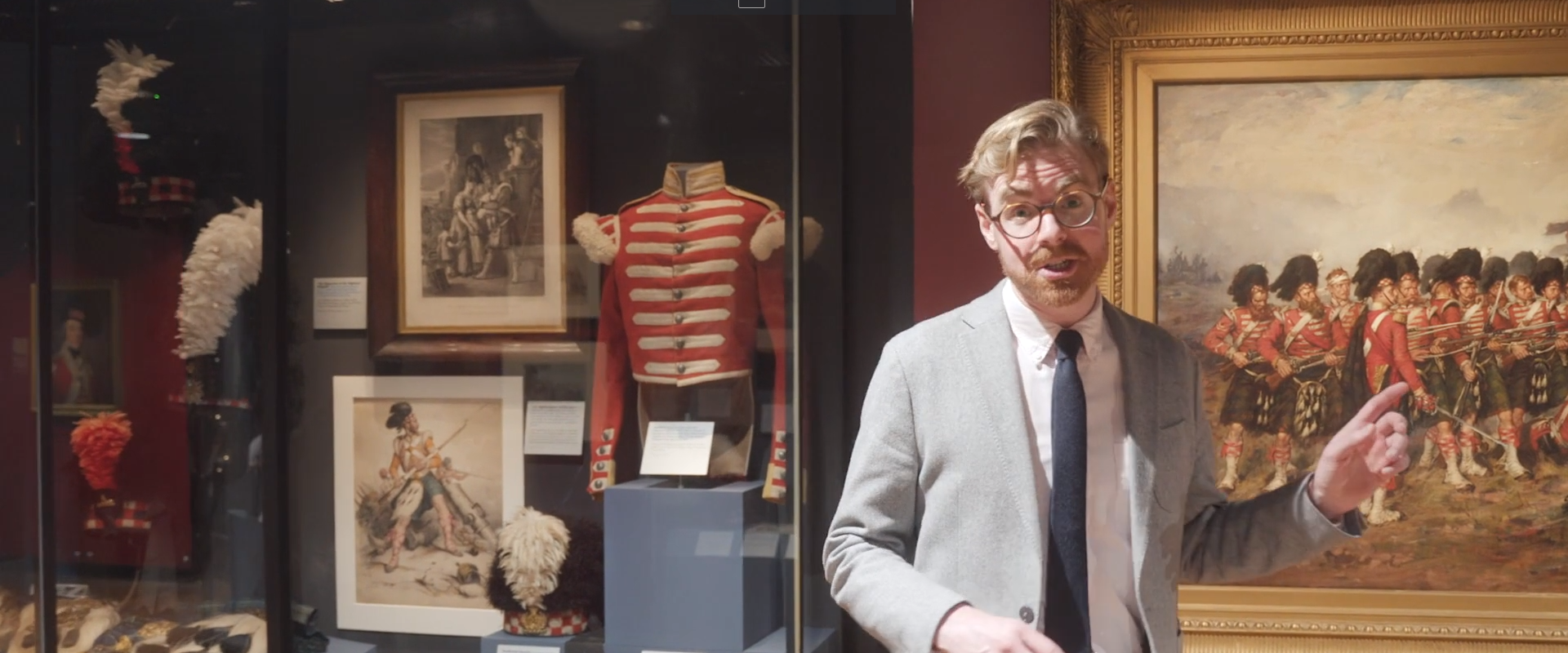Key in a search term below to search our website.
Key in a search term below to search our website.

Who
Calum Robertson, Senior Curator, Modern & Military History
Where
National War Museum
“Biggest misconception? That military history is for enthusiasts... armed conflict has touched us all. It's everybody's story.
There are three of these comical cherubs on display at the National War Museum.
The figures (M.1935.144.1, M.1935.144.2, M.1954.588) depict soldiers in the uniform of the Royal North British Fusiliers around 1720, and are amongst the earliest representations of Scots in British military service. Until 1839, they were used to decorate the Chelsea Bun House, a famous London coffee shop near the Royal Hospital, a home for discharged soldiers founded in the 1680s.
Indicators of their role, rank and regimental identity can be read from their uniform and equipment. The thistle badges on their caps show they belong to a Scottish regiment, while two of the figures carry fusils (a type of light musket from which we get fusilier). The other holds a spontoon, a type of polearm carried by officers as a symbol of their rank.
This mitre cap (M.1996.59) was worn by a grenadier officer of the Royal Ecossais during the 1745 Jacobite Rising.
The regiment was part of the French army and largely made up of exiled Jacobite Scots. Grenadiers were elite troops selected for their strength and height, and the tall cap further emphasised their stature. The large front of the cap also allows plenty space for decoration and this example combines both Scottish and French national symbols such as the thistle and the fleur-de-lys.
France sent support to the Jacobite cause in the form of money, arms and men. However, this cap did not see battle in Scotland. The ship carrying the officer who wore this cap was captured by the Royal Navy.
Holdalls, also known as 'housewives' or 'hussifs', were used by soldiers to keep personal items and sewing kits to repair uniform.
These two examples (M.1937.77.1, M.1961.156.2) were made around 1880. Hussifs could be hung by the soldier's bed or rolled up and carried in the pack. Like many military items that were not issued officially, these have been decorated with personal and regimental symbols.
Sometimes these were made by the men themselves, and sometimes by loved ones and family members. Often they are made from pieces of old uniform. The hussif initialled ‘JC’ belonged to Sergeant John Crichton, who served with the 93rd Regiment (Sutherland Highlanders) at Balaclava as one of the 'Thin Red Line'.
In war, the offensive weapon has been the main tool used by the soldier, sailor or airman. Over the centuries, it has taken many forms: warships, tanks and military aircraft have all been designed as offensive weapons. It is the bladed weapon – such as swords and daggers – that is the oldest form of weapon specifically designed for interpersonal conflict.
However, not all the weapons in this display were designed to be used in combat. The Scottish basket-hilted sword, for example, once synonymous with the Highland armies of the Jacobite Risings, continues to be worn by Scottish army officers as part of ceremonial dress. Long after being technologically superseded, this type of sword still plays an important role in the expression of Scottish military identity.
The Thin Red Line (M.2016.6) is one of the best known of all battle paintings.
It depicts the 93rd Regiment (Sutherland Highlanders) at the battle of Balaclava in 1854, during the Crimean War. It was painted by Robert Gibb in 1881, and the fact that he produced this highly popular and dramatic picture 27 years after the battle suggests how firmly established in the public imagination the reputation of Scotland’s Highland regiments had become.
At Balaclava, the 93rd Regiment fought off an attack of Russian cavalry by forming a line only two men deep in order to increase the effectiveness of their fire. This action was witnessed by a war correspondent for The Times newspaper who described the appearance of the 93rd Regiment as “a thin red streak tipped with a line of steel”. The adapted title proved more memorable.
Artists are always prone to artistic licence. In contrast to the dramatic scene in the painting, the advance of Russian cavalry was halted much further away by the accurate fire of modern rifles.
The Victoria Cross is the most prestigious award in the British honours system, and the highest award a British service person can receive.
The award recognises the most extreme acts of bravery carried out under direct enemy fire. Since its inception in 1856, only 1,358 Victoria Crosses have been awarded. There are twelve in the collections of the National War Museum.
Both medals displayed here were awarded for acts of extreme gallantry during the First World War. One was awarded to Lance Corporal William Angus in 1915, after he rescued a wounded officer under enemy bomb and rifle fire. During the course of this rescue, Angus received around 40 wounds.
The other was awarded to Acting Lance Corporal John Hamilton in 1917. While defending trenches near Ypres in Belgium, Hamilton collected and distributed fresh supplies of ammunition to his battalion whilst fully exposed to the fire of enemy machine gunners and snipers.
The Storming of Tel-el-Kebir (M.1952.50) was painted by the French artist Alphonse Marie de Neuville in 1883.
The picture depicts the 1st Battalion, The Black Watch attacking the defences of Ahmed 'Urabi’s Egyptian army at Tell El Kebir during the Anglo-Egyptian War of 1882.
Tell El Kebir was the decisive battle of the war, and the British victory cemented colonial control over Egypt and ensured access to the economically important Suez Canal. de Neuville was one of the nineteenth century’s foremost military artists, and sought to record the events of the battle accurately. This included being advised by officers who had been present.